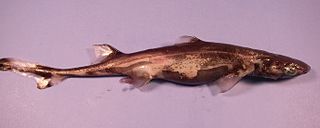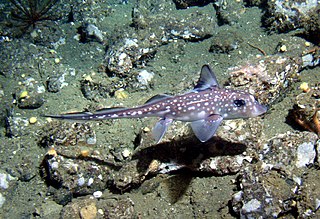
Anomalopidae are a family of fish distinguished by bioluminescent organs located underneath their eyes, for which they are named. These light organs contain luminous bacteria and can be "shut off" by the fish using either a dark lid or by being drawn into a pouch. They are used to communicate, attract prey, and evade predators.

Ophichthidae is a family of fish in the order Anguilliformes, commonly known as the snake eels. The term "Ophichthidae" comes from Greek ophis ("serpent") and ichthys ("fish"). Snake eels are also burrowing eels. They are named for their physical appearance, as they have long, cylindrical, snake-like bodies. This family is found worldwide in tropical to warm temperate waters. They inhabit a wide range of habitats, from coastal shallows and even rivers, to depths below 800 m (2,600 ft). Most species are bottom dwellers, hiding in mud or sand to capture their prey of crustaceans and small fish, but some are pelagic.

Gymnothorax is a genus of fish in the family Muraenidae found in Atlantic, Indian and Pacific Ocean. With more than 120 species, it the most speciose genus of moray eels.

Etmopterus is a genus of lantern sharks in the squaliform family Etmopteridae. They are found in deep sea ecosystems of the Atlantic, Indian and Pacific Oceans.

Sillago is a genus of fish in the family Sillaginidae and the only non-monotypic genus in the family. Distinguishing the species can be difficult, with many similar in appearance and colour, forcing the use of swim bladder morphology as a definitive feature. All species are benthic in nature and generally coastal fish, living in shallow, protected waters although there are exceptions. Minor fisheries exist around various species of Sillago, making them of minor importance in most of their range. This genus has the widest distribution of any smelt-whiting genus, spanning much of the Indo-Pacific. The genus ranges from the east coast of Africa to Japan in the east and Southern Australia in the south, with most species concentrated around South East Asia, the Indonesian Archipelago and Australia. Many species have overlapping distribution, often making positive identification hard.

Hydrolagus is a genus of fish in the family Chimaeridae found in the Atlantic, Indian and Pacific Oceans.

Rhynchobatus is a group of rays commonly known as wedgefishes in the family Rhinidae. They are found in the tropical and subtropical Indo-Pacific with a single species in the eastern Atlantic. All species in this genus are assessed as Vulnerable or Endangered by IUCN.

Coralliozetus is a genus of chaenopsid blennies mostly found in the eastern Pacific Ocean with one species (C. cardonae) occurring in the western Atlantic Ocean. Additionally, one species (C. clausus) is endemic to Cocos Island, Costa Rica.

Eptatretus is a large genus of hagfish.
Halieutopsis is a fish genus in the family Ogcocephalidae.
Neenchelys is a genus of snake eels native to the Indian Ocean and the western Pacific Ocean. All species of Neenchelys have two rather than three preopercular pores, a significant character among many species of ophichthids.

Oneirodes is a genus of fish in the family Oneirodidae.

The splitfin flashlightfish or two-fin flashlightfish is a species of fish in the family Anomalopidae. It is found in warm waters in the central and western Pacific Ocean near shallow reefs 200–400 m (660–1,300 ft) in depth. It can grow to a length of 35 cm (14 in) TL. It is the only known member of the genus Anomalops.
Parmops is a genus of flashlight fishes found in the deep waters of the central Pacific Ocean. P. coruscans is found in the Eastern Pacific around Tahiti and P. echinatus is found in the Western Pacific around Fiji.
Phthanophaneron harveyi, the Gulf flashlightfish, is a species of saltwater fish of the family Anomalopidae. It is endemic to the Gulf of California. This cryptic fish is the only known member of the genus Phthanophaneron. It was first reported in the Pacific Ocean in 1976 and is extremely rare.

Parapercis is a genus of sandperches belonging to the fish family Pinguipedidae.
McCosker's worm eel is a species of fish in the worm eel family Ophichthidae. It was first described by Yusuke Hibino, Ho Hsuan-Ching, and Seishi Kimura in 2012. It is a marine, deep water-dwelling eel which is known from the northwestern Pacific Ocean, including Taiwan and Japan. It dwells at a depth range of 100 to 400 metres, and leads a benthic lifestyle; it is collected by bottom trawlers. Males can reach a maximum total length of 52.2 centimetres (20.6 in).
The flashlight fish is a species of anomalopid fish of the order Beryciformes. It is native to the western Indian Ocean and the Red Sea where it is found near coral reefs. It is a nocturnal predator, hiding in crevices and caves by day and emerging to feed at night. At 11.0 cm (4.3 in) in length, it is small and relatively stout. Its body is mostly solid black, with the exception of white discoloration around its pectoral fins and a lateral line of reflective scales. It is most notable for the bioluminescent organs located underneath its eyes, which it uses to find prey, evade predators, and communicate with other members of its species. Like other Beryciformes, its reproduction is oviparous. It has no commercial value, and this combined with its timid, nocturnal nature makes population sizes and trends unknown. It is listed as Least Concern by the International Union for Conservation of Nature (IUCN) due to a wide distribution and lack of known threats.
Protoblepharon mccoskeri, the Taiwanese flashlight fish, is a flashlight fish species found in the Northwest Pacific off of Taiwan's east coast. It can be found as deep as 300m. It was first described in 2012 from a single specimen caught near Taiwan.
Protoblepharon rosenblatti, the Cook Islands flashlightfish, is a species of flashlight fish found in the waters surrounding the Cook Islands. It can reach lengths of up to 22.0 cm (9 in) and can be found as deep as 274 m (900 ft).










